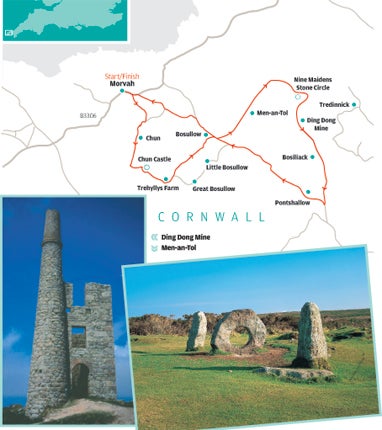Peace and quiet are a stone's throw from the coast
Walk of the month: Even at the height of summer, this part of Cornwall offers splendid isolation, writes Mark Rowe

West Penwith, the most westerly part of Cornwall, claims to have a higher concentration of Celtic and megalithic monuments and menhirs than any other comparable area of Europe, including Brittany. Some of the most striking can be found in the hinterland, as the north and south coasts converge at Land's End.
The contrast with the busy coastal path and tourist tat of Land's End could not be greater. Even on a bright summer's day, you will find tranquillity among the empty upland granite moors – the cairns, stone circles and rings are your only companions.
The walk starts from the church in Morvah – please park considerately along the lane here. Cross the B3306 and walk ahead to take a gate and a stone stile and keep ahead, following the edge through successive fields, crossing each one by stone stiles. Just before you reach Carne Farm, bear half right across the field, following the waymarkers and passing through the gap in the electric fence.
Head for the stile in the field edge to join a track, with the farm on your left, and go straight ahead on the track. This leads on to Chun Downs nature reserve, an area of western lowland heath that accounts for a quarter of all Cornwall's heathlands. These are real granite uplands, the sort of territory you expect to see in the Yorkshire Dales rather than in a major tourist area. As summer moves on, the landscape is lit up with heather.
The word "chun" comes from the Cornish "chy-an-woone", or house on the downs, and refers to the remnants of the prehistoric hill fort that the path leads to.
Bear left along the main path as it weaves through the gorse and heather before following a clear track uphill with a field edge on your right. At the brow of the hill, you'll pass the well-preserved burial chamber Chun Quoit. Here, bear left towards the hill fort, which dates from about 500BC. Much of the fort was taken away to pave local towns and villages, but the outer ring remains substantial and offers superb views. Far away to the north east stands the outline of Ding Dong Mine, reached later on this walk.
From the hill fort, follow the narrow grass track that runs around the west and south edge of the fort, and which drops downhill towards some farm buildings. Here, turn left along the track through the farm, which becomes a more substantial lane and continue on this for a mile and a half until you reach a junction with the Morvah-Penzance road. Turn right and then left opposite the Men-an-Tol studio, following a farm track between fields.
After half a mile, turn right over a step, following the sign to the Men-an-Tol, one of Cornwall's most iconic monuments and thought to date from the Bronze Age. The site consists of three stones and a hollowed stone circle, its origins are unclear but are thought to relate to fertility rituals. From here, return to the track and bear right. After a couple of hundred yards you'll see a standing stone, Men Scryfa, in a field, with an inscription believed to be from the early Christian era. Continue along the path, bearing right uphill to reach the top of the moorland. Here you'll pass two stone circles, including the Nine Maidens, a Bronze Age circle.
Pressing on, the path brings you round to the Ding Dong mine, arguably the best preserved of Cornwall's tin mines, and one of the least visited. It dates back to the 17th century.
From the mine, take the main rough track that heads downhill, through a gate and past an underground reservoir. The path bends to the right, and offers superb views of Mounts Bay and St Michael's Mount. On either side are classic Cornish fields, edged with turfed stone walls and covered with wild flowers. The path becomes a more substantial road and passes Bosiliack Farm. Where this meets a road, turn right and follow this road for the two miles back to Morvah. Along the way, look out for Lanyon Quoit, which comprises three upright stones and a capstone and is thought to have been a burial chamber.
The road forks about a mile above Morvah – take the left-hand route, with views down to the sea and the village church. On your return, the church is worth visiting. Named for St Brigitte of Sweden, it reflects the popularity of the saint in Cornwall in the 14th century and is thought to be the only church in the UK named after her. A Swedish flag stands inside, along with a beautiful cut-glass figure of the church. Around the corner is a lovely teahouse, built in the old village school.
Compact Facts
Distance: 10 miles
Time: Four hours
OS Map: Explorer 102
How to get there
Mark Rowe stayed at Saltings Loft 2 in Lelant, courtesy of Cornish Gems (0844 800 2813; cornishgems.com), which costs from £1,006 per week in high season.
Further information
For train fares and timetables contact First Great Western (first greatwestern.co.uk).
Join our commenting forum
Join thought-provoking conversations, follow other Independent readers and see their replies
Comments